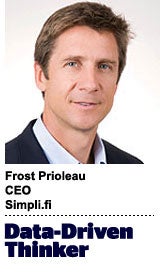 “Data-Driven Thinking” is written by members of the media community and contains fresh ideas on the digital revolution in media.
“Data-Driven Thinking” is written by members of the media community and contains fresh ideas on the digital revolution in media.
Today’s column is written by Frost Prioleau, CEO and co-founder of Simpli.fi.
In their seminal book, “The One-to-One Future,” communications strategists and futurists Don Peppers and Martha Rogers imagined a world beyond mass marketing. Somewhere beyond the television industrial complex was a world where the four P’s of classical marketing theory – product, place, price and promotion – were replaced with five I’s: identification, individualization, interaction, integration and integrity.
Their vision, put forth in 1996, turned out to be prescient. Today’s programmatic marketing technologies place true one-to-one marketing within our reach, and the possibilities are as exciting as a road trip to the Grand Canyon. It’s no wonder the industry can sometimes sound like an impatient kid in the backseat asking, “Are we there yet?” Across all of the I’s, developments in the last few years pushed us quickly in the right direction.
Identification: Peppers and Rogers ushered in the age of precision marketing, marked by the segmentation of audiences into target audiences. This allowed marketers to hone their messages and channels based on the characteristics and behaviors of a smaller audience, increasing relevance and efficiency. The technology of the day was built to support the methodology. However, in the era of big data, we find that “precision” can now take on a new meaning.
We no longer have to group users into opaque audience segments and then treat all users within those segments the same. Instead, we can now make real-time marketing decisions based on anonymous data about individuals – data such as search history, browsing patterns, CRM history, location, recency and device. The further adoption of targeting at the individual user level, as opposed to the segment level, is the most important bridge that the industry must cross to achieve the promise of one-to-one marketing.
Individualization: Search marketing moved the digital advertising industry light years closer to the goal of one-to-one individualization. Based on a single intent-based search, advertising could deliver guaranteed relevancy to the consumer and value to the advertiser. Further individualization in search is achieved with Dynamic Keyword Insertion, which changes the text of an ad to match one of the user’s search terms. In display, ads can also be individualized based on a variety of inputs, including terms that the user searched on, product pages visited, CRM data about the user, current weather conditions in the user’s city and more.
The key to true one-to-one individualization is data granularity, so that instead of customizing a Starbucks ad to a “soccer mom,” ads are customized to the user who ordered the nonfat pumpkin spice latte three days ago (as captured by her frequent buyer card). The ability to bid and deliver advertising messages customized to an individual, reminiscent of “Minority Report,” exists today. To get there, however, the industry needs to move to a more precise way of storing and bidding on audience data.
Interaction: While much is made of social media and “engagement,” Peppers and Rogers saw future interaction as a dialogue between brand and consumer – an ongoing relationship based on mutual benefit. With corporate Facebook, Twitter, Pinterest and Instagram accounts, consumers can engage like never before. And as we move towards increased multichannel interaction, these communication lines will only expand. The integration of CRM data and other unstructured data also paves the path for a more robust interaction between advertiser and consumer based on actual transactions, contextual recommendations and timed messaging.
Integration: We still have a long road ahead on integration. From the standpoint of an advertiser’s relationship to the customer, there are still far too many cooks in the kitchen. The ad-tech ecosystem will have to move away from point solutions for targeting methods, media types, ad servers, contextual analysis, brand safety and the like. Consolidating messaging on fewer platforms that can deliver multiple advertising tactics (search retargeting, site retargeting, contextual targeting, CRM targeting, etc.) across multiple media types (display, mobile, video, etc.) is the way forward. And with integration will come greater efficiencies and deeper audience insights.
Integrity: Our best laid plans, however, hinge on one concept: trust. As an industry, we must take responsibility for acting in ways that will build trust with both advertisers and consumers. Eliminating fraudulent impressions and clicks, adopting accurate and reliable viewability measures, using audience data only in responsible ways, enabling easy and universal opt-outs – all are areas where our industry needs to step up its game. Without continuing efforts and progress in these areas it could all be for naught.
It has been a long journey. So, are we there yet? From a technology perspective, I think we have arrived. The advances made in real-time bidding, dynamic ads, unstructured data, CRM targeting, cross-device targeting and social media have all pushed us down the road to true one-to-one marketing. But there is always another leg to the journey. The final stretch will be less about waiting for new technologies to be developed, and more about humans adapting to the new possibilities.
Follow Frost Prioleau (@phrossed), Simpli.fi (@Simpli_fi) and AdExchanger (@adexchanger) on Twitter.











